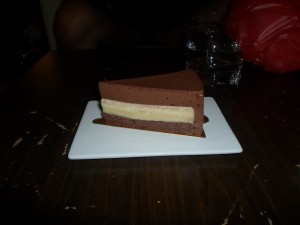Rachelle and I have been swamped lately, but I need to keep in the habit of blogging. So I figure I’ll share my experience with another of the strange fruits of southeast Asia — the Durian.
The durian is known as “The King of Fruits.” It is large, spiky, and stinky. You could probably kill someone with one, but the reason they’re banned from some places is the smell. When I first arrived in China I thought durians smelled a little off – it’s kind of difficult to describe the smell, but most people unfamiliar with it would describe it as a stink of some fashion. The smell eventually grew on me, though, and I worked up the courage to try some durian candy I found in our local Park’n'shop. The candy was both sweet and garlicky, and I had sulfurous burps which reminded me of garlic and vulcanized rubber for some time after. Despite my description, it wasn’t bad per se, and the more I tried, the more it grew on me. And so, when I got to speaking with one of my Chinese teacher friends on the subject of spiky deathfruit, and she invited me to have some real durian, I knew I could not decline, especially as the peak season for durian (in the summer months) was drawing to a close.
And so it was that I found myself standing in front of a rather large display of durian on a side street under a highway interchange (“They have the best durian”), trying to make sense of how my friend was choosing a good fruit.
After she had found one and had the shop owner break it open and package the flesh, we went to a nearby park to enjoy our stinky bounty. The elderly Chinese walking around the park and slapping themselves stared in amazement at a foreigner in their park–especially one eating such a fruit!–but we paid them no mind and begun to dig in.
Durian flesh, ideally, is supposed to be soft and creamy, with a texture reminiscent of a firm custard. Ours wasn’t perfect, so there were some bits of flesh that were firm and mostly flavorless (the white parts). The taste is harder to describe than the smell–it’s slightly sweet, definitely sulfurous, with a hint of onion somewhere in there. If you can get past the first few bites, it’s said, you’ll be hooked, and I found myself eating more and more, until my face was messy with durian pulp and all we had left were the pits. The seeds are large and woody, and are supposed to be edible when cooked, but not really worth the trouble.
My friend brought out a bag of mangosteens. Durians supposedly raise heat in the body (according to traditional Chinese medicine), so it is customary to follow durian with a cooling fruit, like mangosteen.
You cannot eat the outer shell–it is woody and so bitterly astringent that you would immediately regret such an attempt. Generally, you can use your nails to pull it apart, or crack it open with a firm twist, trying to get as little juice as possible on your clothes (it stains!) or on the flesh inside (detracts from the flavor). Once it’s opened, you can eat the squishy white flesh, being careful of the seeds in the larger segments, and enjoy a flavor that kind of reminds me of pear and grape, only sweeter and lighter.
It was dark by then, so my friend and I went to the local artist and hipster neighborhood for one more tasty anomaly.
Chocolate and wasabi cheesecake. Where is your god now.








